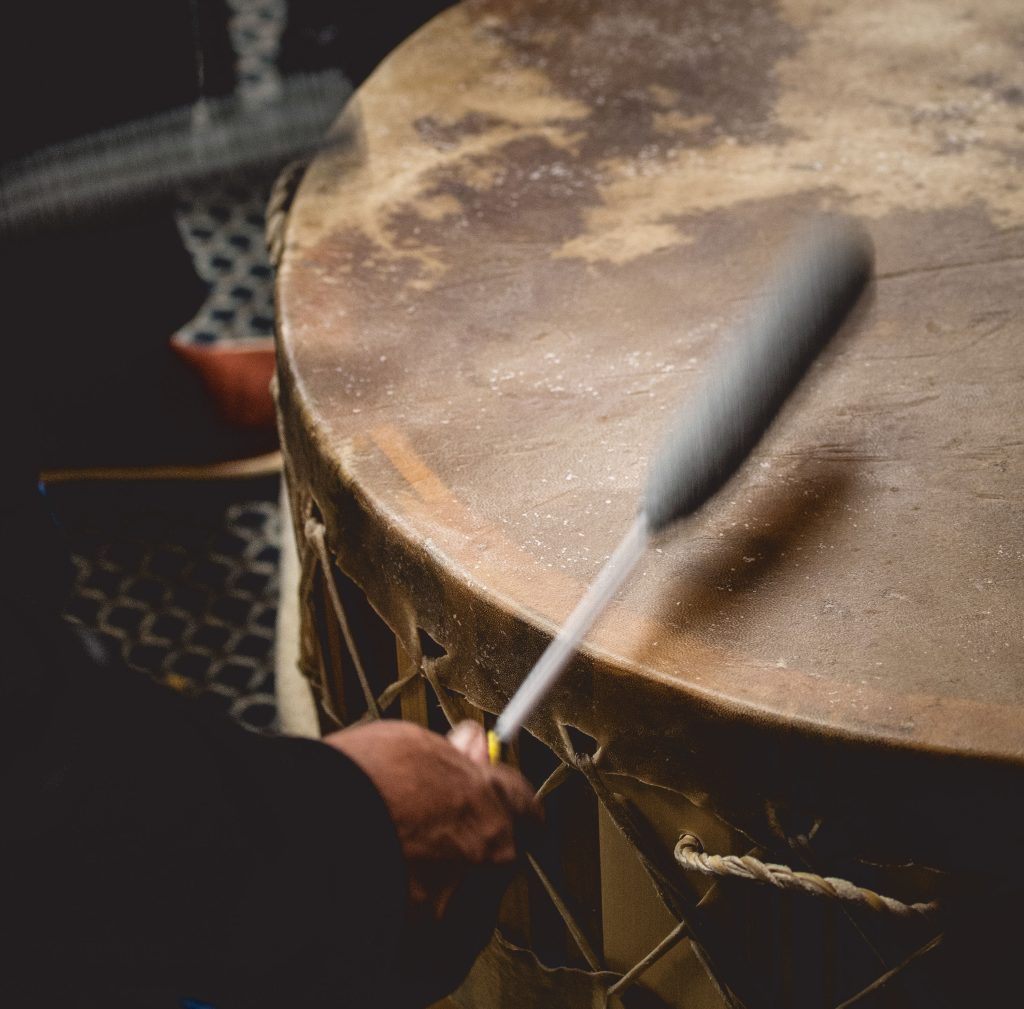Thomas Fantasia speaks articulately, then cuts himself off. Modest, respectful, cautious. He interrupts himself to emphasize: he’s still learning.
“There’s so much more I have to learn about our traditional dances and songs,” says Fantasia. “I’m only speaking on my experience. I don’t speak for other communities that may have other understandings… I share from a good and humble place; there are plenty of people more qualified than I am.”
Fantasia is a member of the Wampanoag Tribe of Gay Head (Aquinnah). He is an Indigenous singer, song maker, and drummer who composes intertribal powwow songs as well as songs traditional to his home community, including Eastern-style round dances and robin dance songs.
He grew up on Martha’s Vineyard (Noepe), then moved about, spending time in Westerly then the Pacific Northwest. Eventually he moved to Connecticut, where he works in IT support and travels all over performing with drum groups in powwow ceremonies and social events up and down the East Coast and beyond.
“I was about 13, 14 when I really started to embrace [powwow] thanks to my oldest brother, Tobias. He encouraged me and invited me to drum practices,” says Fantasia. By the time he started high school, he was traveling with his brother and cousins to sing at different events. “After being exposed to powwows and seeing the dancers and listening to the drums, I thought it was really cool, so I practiced more and more; I immersed myself in it.”
With powwow style singing, men sit around a drum, anywhere from 22 to 30 inches in diameter. The drums are typically made from deer, cow, or horse hide. “Different animal hides are used to make drums, and they kind of sound different… One of the common teachings as a singer I’ve been taught is you take care of that drum.”
The drum is seen as a living entity, often acknowledged as a “grandfather” for what it carries. “In our traditional teachings, the drum is the heartbeat of the land, the heartbeat of the nation. The reason why the men sit at the drum is because our role in society and, for our family in general, is to take life. Whereas, a woman’s role is to give life. By singing on that drum, we’re given the opportunity to exercise something similar to what women do naturally.”
Eastern style singing uses a particular beat pattern that is more staggered than a tribal powwow beat; the song’s rhythm differs, too.
“With a tribal powwow style, we call it off the beat, whereas, traditional Eastern singing is sung on the beat. The vocals used are a little bit different too. Also, with a lot of Eastern songs, at least to my knowledge, we don’t sing a whole lot in the language.”
Fantasia began song making by learning the songs of the Black Brook Singers. He would compose songs that followed their rhythm and cadence. Over the years, as he traveled to more powwows and sang with different drum groups, Fantasia accumulated a library of sounds and compositional influences to inspire his song making, while continuing to acknowledge: song as gift.
“These songs come from our belief that they came from the creator; they’re given to us. Sometimes the song is given in pieces. I’ll get a piece and then I’ll try to piece the rest of it together. Sometimes the song comes to me in completeness. But over time, years later, I’ll listen to it and be like, ‘I want to make this change.’
“I feel it’s very important to have an understanding of the foundation of where these things come from as I’m creating, and that I’m doing it in the same spirit as those who came before me, not in a way that dishonors or disrespects where it came from.”
As Fantasia began thinking more intensely about the traditional style of songs, he realized colonization and assimilation hit East Coast tribes differently than tribes further West.
“We’ve had to deal with the impacts of colonization much longer than everybody else. What has come with that? Unfortunately, certain teaching songs have fallen through the cracks… The initial intent of colonization and assimilation was to kill the Indian, save the man. And if you couldn’t save the man, do away with both… There was a time when speaking our language, singing, and dancing were illegal. It was literally illegal to be an Indigenous person. You could be born of the tribe, but you couldn’t culturally be of your tribe.”
It took until 1987 for the Wampanoag tribe to obtain federal acknowledgement and the US government to take responsibility for its injustices and grant partial restitution for land unjustly taken.
“The fact my great grandparents and grandparents before them fought and adapted and did what they had to do so we could continue, if that’s not perseverance, I don’t know what is.

“I’ve been privileged to sit with some legendary groups, and in those times I’ve tried to ask other lead singers and people who’ve been doing it so much longer than [I have] for their wisdom and knowledge. This has helped me grow as a person, not just as an artist. That’s what I hope to accomplish – to inspire younger generations to pick it up and keep it going, to grow into the man or woman they wanna be.”
More Posts by The Author:
On the Cover: Sophie Foulkes
The Progress Flag & the Danger of Empty Gestures
Note from the Editors
Women’s Health & Education Fund: To ensure all Rhode Islanders have access to safe abortions and contraceptive care despite the cost
On The Cover: Fu’una

